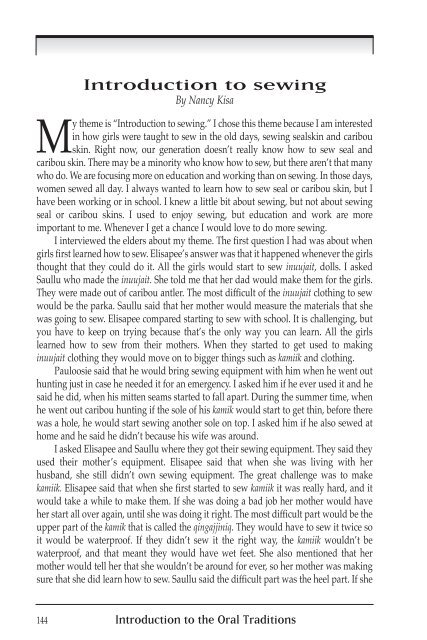Introduction-E
Introduction-E
Introduction-E
Create successful ePaper yourself
Turn your PDF publications into a flip-book with our unique Google optimized e-Paper software.
<strong>Introduction</strong> to sewing<br />
By Nancy Kisa<br />
My theme is “<strong>Introduction</strong> to sewing.” I chose this theme because I am interested<br />
in how girls were taught to sew in the old days, sewing sealskin and caribou<br />
skin. Right now, our generation doesn’t really know how to sew seal and<br />
caribou skin. There may be a minority who know how to sew, but there aren’t that many<br />
who do. We are focusing more on education and working than on sewing. In those days,<br />
women sewed all day. I always wanted to learn how to sew seal or caribou skin, but I<br />
have been working or in school. I knew a little bit about sewing, but not about sewing<br />
seal or caribou skins. I used to enjoy sewing, but education and work are more<br />
important to me. Whenever I get a chance I would love to do more sewing.<br />
I interviewed the elders about my theme. The first question I had was about when<br />
girls first learned how to sew. Elisapee’s answer was that it happened whenever the girls<br />
thought that they could do it. All the girls would start to sew inuujait, dolls. I asked<br />
Saullu who made the inuujait. She told me that her dad would make them for the girls.<br />
They were made out of caribou antler. The most difficult of the inuujait clothing to sew<br />
would be the parka. Saullu said that her mother would measure the materials that she<br />
was going to sew. Elisapee compared starting to sew with school. It is challenging, but<br />
you have to keep on trying because that’s the only way you can learn. All the girls<br />
learned how to sew from their mothers. When they started to get used to making<br />
inuujait clothing they would move on to bigger things such as kamiik and clothing.<br />
Pauloosie said that he would bring sewing equipment with him when he went out<br />
hunting just in case he needed it for an emergency. I asked him if he ever used it and he<br />
said he did, when his mitten seams started to fall apart. During the summer time, when<br />
he went out caribou hunting if the sole of his kamik would start to get thin, before there<br />
was a hole, he would start sewing another sole on top. I asked him if he also sewed at<br />
home and he said he didn’t because his wife was around.<br />
I asked Elisapee and Saullu where they got their sewing equipment. They said they<br />
used their mother’s equipment. Elisapee said that when she was living with her<br />
husband, she still didn’t own sewing equipment. The great challenge was to make<br />
kamiik. Elisapee said that when she first started to sew kamiik it was really hard, and it<br />
would take a while to make them. If she was doing a bad job her mother would have<br />
her start all over again, until she was doing it right. The most difficult part would be the<br />
upper part of the kamik that is called the qingajjiniq. They would have to sew it twice so<br />
it would be waterproof. If they didn’t sew it the right way, the kamiik wouldn’t be<br />
waterproof, and that meant they would have wet feet. She also mentioned that her<br />
mother would tell her that she wouldn’t be around for ever, so her mother was making<br />
sure that she did learn how to sew. Saullu said the difficult part was the heel part. If she<br />
144 <strong>Introduction</strong> to the Oral Traditions


